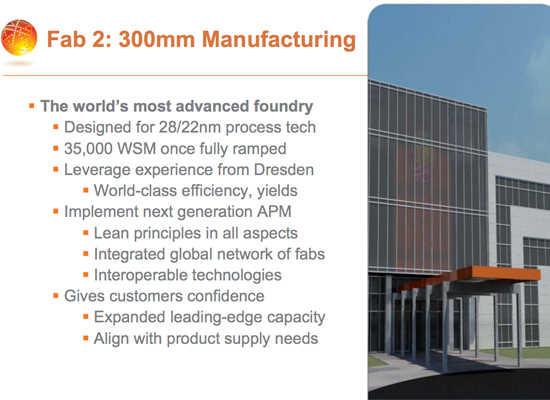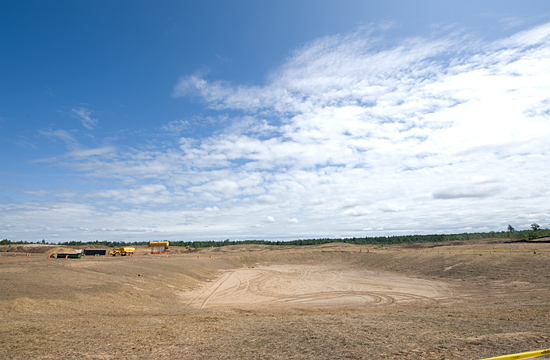Globalfoundries Starts on 22nm Fab & Announces First non-AMD Customer
by Anand Lal Shimpi on July 29, 2009 4:01 AM EST- Posted in
- CPUs
Meet Fab 2
Let’s get the numbers and politics out of the way. Fab 2 will be built in Saratoga County, NY. The plant will cost $4.2 billion to complete, but with the deep pockets of ATIC and tax incentives from the state of NY, this won’t be a problem. When it’s finished you’re looking at more than 1,400 high skilled jobs. It’ll take a couple thousand construction workers to build the place and when it’s all done Globalfoundries is estimating 5,000 ancillary jobs (gotta feed the engineers and entertain their families). Globalfoundries is also contributing $5M to community projects to the two towns that border the Luther Forest Technology Park where Fab 2 will be built. In short, there’s a lot of money going around.

The location actually makes a lot of sense. Just a few miles away is the College of Nanoscale Science and Engineering, a part of the University at Albany. CNSE is not your normal graduate campus; the $4B campus actually houses a modern microprocessor fab facility capable of producing 300mm 45nm wafers just like the best Globalfoundries has to offer today. While the plant is purely a research fab (limited to 25 wafers per day vs. ~1200 per day at Fab 2), it’s serves its purpose for companies and students looking to perform research at an advanced microprocessor fab. CNSE also holds one of the two alpha EUV lithography machines in the world; EUV lithography will be needed to replace immersion lithography to scale down beyond 22nm.

That's where Fab 2 will go
When Fab 2 comes on line in 2012 it'll be a 28nm/22nm fab, with the bulk of its production hopefully being 22nm.

Half vs. Full Nodes
I asked Globalfoundries a question that I'd always wondered for myself: why are GPUs manufactured on half nodes and CPUs manufactured on, er, whole nodes? Let me give you an example.
Intel's CPU transitions went from 90nm to 65nm to 45nm and are now moving to 32nm. AMD followed a similar path.
NVIDIA's GPUs however went from 90nm to 80nm to 65nm to 55nm to 40nm in roughly the same time period. ATI's GPUs did the same.
The in-between nodes (80nm, 55nm and later 28nm) are called half-nodes. And the CPU guys don't use them simply because their design cycles are longer and more complex than what comes out of ATI/NVIDIA. There's no technical downside to using half nodes, it's just added design work for little benefit for a CPU maker.
GPU design cycles are much shorter, so taking advantage of half nodes just makes sense. It all stems from the birth of the 6 month product cycle back in the late 1990s.










50 Comments
View All Comments
ClownPuncher - Wednesday, July 29, 2009 - link
98 F in Redmond currently, no AC in my house...I'm glad I went with some high CFM fans in my air cooled PC!BillyAZ1983 - Wednesday, July 29, 2009 - link
Pffft, here in lovely Bullhead City is a very chilly 120F. Pretty soon I might have to go get my jacket.JarredWalton - Thursday, July 30, 2009 - link
Ah, but I'd wager you have AC. Washingtonians don't believe in such things (at least not for homes), since it "never" gets that hot here. Ugh.... My house started at 86F this morning (8AM), got to 91F by noon, and reached a high of 96F by 6PM. Currently it's back down to 92F - yes, at 10PM. The fan by the door isn't helping much, considering it's only a few degrees cooler outside.strikeback03 - Wednesday, July 29, 2009 - link
...until I read that it was in Malta. Where there would certainly be rain if it was outdoors.Sottilde - Wednesday, July 29, 2009 - link
Hey Anand, thanks a ton for turning me on to CNSE. I was just starting my search for a graduate program. I'm determined not to be a CS code monkey the rest of my life!Pirks - Thursday, July 30, 2009 - link
I don't see how being a wafer pressing monkey is any betternunocordeiro - Wednesday, August 5, 2009 - link
Good luck fort you! CNSE does look like a good carrer investment. And don't mind Pirks. He is our own little private joke around these parts.blyndy - Wednesday, July 29, 2009 - link
The graph shows GF starting 32nm production in Q1 2010, which sounds great considering Intels 32nm product will start selling in Q4 2009.But it's easy to forget that it's many months between the start of volume production and the start of retail availability.
So, realistically, how long before a 32nm AMD CPU is available in retail? I would imagine the very end of Q3 2010 at the earliest, more likely mid-Q4, with a majority 32nm lineup a year after that. So, that is still roughly a year after Intel, but given previous transition timetables, not bad at all!
blyndy - Wednesday, July 29, 2009 - link
I like reading about the insides and technologies in fabs.Einy0 - Wednesday, July 29, 2009 - link
Yes, very interesting stuff... Nice to see this working out for GF / AMD... In fact to whole semi-conductor industry gets a new player with big money to build new high quality chips on cutting edge technology.